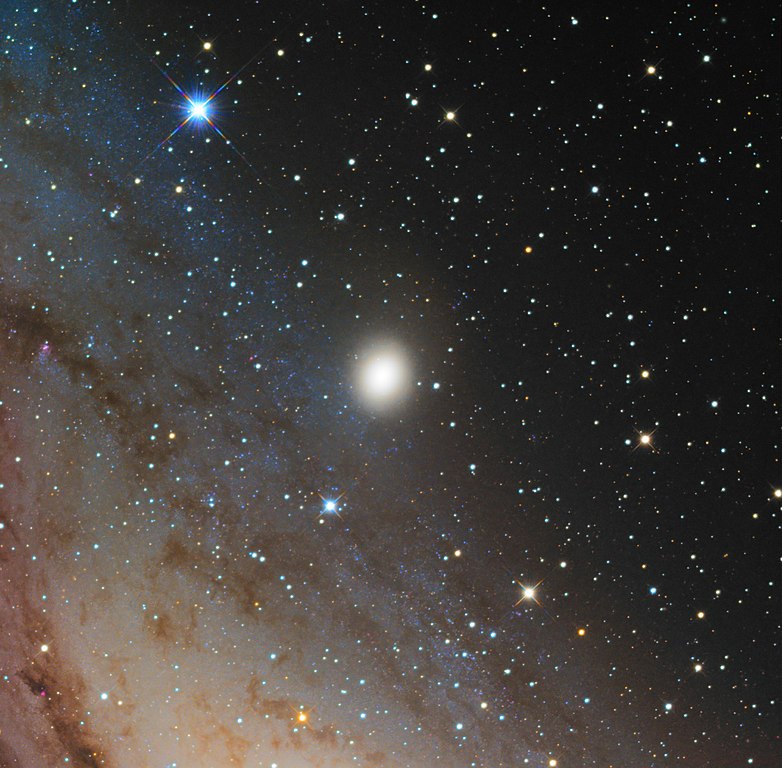Interstellar Societies: Possibility or Improbability?
The future of interstellar travel may be the most important factor when considering SETI strategy. Are societies spanning entire galaxies, with billions of inhabited worlds, likely to exist? Are they even possible? Two new papers that I have submitted consider this issue in very different ways.
Interstellar travel has many difficulties, especially if we want to go beyond quick flybys to actually voyaging to nearby stars with a crew. One of them is the sheer distance between the stars. It would take decades or centuries to reach our nearest star, Proxima Centauri. Another is the stuff in between the stars, especially the dust grains lurking in the interstellar medium. When travelling at a good fraction of the speed of light, dust grains become missiles that can inflict terrible damage on a starship. Yet most of the arguments against interstellar travel have a hidden assumption: that starfarers live in an environment like that found around the Solar System. My first paper proposes the idea of galactic traversability — interstellar flight may be much easier in some types of galaxies than others.
Let's take the distance between stars. The flight time depends on the density of stars, but stellar density is not constant even within galaxies. The space around the centers of galaxies is relatively packed with stars, so interstellar flights will be shorter and easier to accomplish. This in fact is one of the motivations for Breakthrough Listen's Galactic Center survey. But there's another way to speed up starflight: rather than trying to go to the stars, one could let the stars come to you. This is faster in some galaxies than others. In large elliptical galaxies, stars are moving every which way at hundreds of kilometers per second. Those speeds are slow compared to those of hypothetical fusion or antimatter rockets, but they're much faster than the speeds we achieve with our chemical rockets. It's all a matter of patience, but in elliptical galaxies, one does not have to be as patient.

Galactic traversability also considers the interstellar medium. The Milky Way is a star-forming galaxy, and that star formation is fueled by large (though declining) reservoirs of gas and the dust within it. But not all galaxies are star forming. The quiescent galaxies include most elliptical and lenticular galaxies. Not all of these galaxies are entirely clear of dust and gas, but most of them have much less than the Milky Way, and the ones in galaxy clusters — like the Virgo ellipticals we are observing — have very little. These galaxies may be "super-traversable": interstellar travel could be much easier than in the Milky Way. What I find most interesting is that these galaxies actually contain the majority of stars in the universe. Perhaps most ETIs do not find flight to nearby stars to be hazardous journeys filled with peril, at least not to the extent we would. The most traversable galaxies in my judgement are the compact elliptical galaxies. These appear to be the former cores of larger ellipticals whose outer envelopes have been ripped away by tidal forces. As the cores of galaxies, their stellar densities are high, the stars move around fast, and they're also thought not have much of an interstellar medium. Although fairly rare, we are fortunate enough to have a compact elliptical in our intergalactic backyard: Messier 32, a satellite of the Andromeda galaxy.

But there's a second argument against starfaring, and it seems to rise from a notion at the heart of the SETI enterprise: the Copernican Principle. The Copernican Principle says that we are not at a special location in the universe. We do not think life and intelligence are miracles that could only appear on our Earth, but evolve through processes with some chance of happening on other worlds, nearly inevitably in a large enough universe. We are sometimes said to live around an unremarkable star in an unremarkable galaxy. But if the Earth is fairly normal, doesn't that mean we should expect ourselves to be fairly typical as well? For example, some astronomers believe this means that we should expect most ETIs to live in similar environments as us, around yellow stars like the Sun instead of the more numerous red dwarfs and in spiral galaxies instead of ellipticals. One of the most controversial takes on the Copernican Principle is the Doomsday Argument, which says that we probably are not living in a special time in our history, but instead we're more likely in the middle. Although that seems innocent enough, it directly implies that interstellar migration will not happen. A long-lived interstellar society with millions of inhabited worlds could sustain countless trillions of inhabitants, but only about 100 billion humans have been born so far. So if humanity is destined to go to the stars, we are among the very first humans to ever live — and the Doomsday Argument rejects such an extreme "position" in history. According to the Doomsday Argument, this is not a mere improbability either: the odds could easily be countless trillions to one against that. Even without interstellar travel, the Doomsday Argument also rules out a long future on Earth, which directly ties into the lifetime factor of Drake's equation. If we accept the argument, detecting ETIs is nearly impossible.
These "typicality" or "Copernican" arguments have high stakes not just in SETI, but in fundamental physics and cosmology. They may even be needed when reasoning about what we see in an infinite universe. My second paper, "The Noonday Argument", is my take on the subject. One theme is that not every plausible-sounding appeal to the Copernican Principle is valid. The title's Noonday Argument is an example: just as we are not at the center of the universe, surely we're not at the center of history? According to the Noonday Argument, the "beginning" of history is one of the most reasonable places we could be. The Noonday Argument does parody one version of the Doomsday Argument, but there is a rather different version based on Bayesian reasoning, which interprets probability as a way to measure our confidence ("credence") in a belief. Basically, according to this version, there are more possible people you could have been in a long interstellar future, and by a kind of Occam's Razor, models with fewer people are favored. One of my arguments is to take this reasoning to the extreme. A favorite topic of philosophy students is solipsism: maybe you're the only real person in existence and you're just dreaming up everyone else! The reasoning behind the Doomsday Argument favors solipsism by a factor of billions to one. You're the most typical person in existence if you're the only person in existence! I contend this actually goes against the spirit of Copernican Principle, because instead of there being many worlds, there would be just one — yours.

The bulk of the paper delves into the philosophy as it tries to balance cases where typicality can work and when it should not. What I suggest is that instead of having just one probability distribution like in normal Bayesian reasoning, you would have several, each one made under the assumption that you are at a particular location. These get averaged together to get our level of belief. As we narrow down the range of locations we could be located at, the averaging changes to reflect this. Another theme of the paper is that details matter. Rather than considering everyone to be an interchangeable "observer", it matters who is who. Typicality emerges from the number of different ways intelligent beings can be arranged in time and space, just as a fair coin will tend to turn up heads half the time if flipped enough times even though a sequence of all-heads is just as likely as any other specific series of coin flips. If my work is right, then the Doomsday Argument fails when we try to apply it to ourselves because of both the averaging and combinatorics. My paper does not solve all the puzzles related to these typicality arguments — there are some situations where the system I suggest tends to favor the existence of "exotic" intelligences — but it adds another piece to the puzzle. My personal guess is that we cannot rule out the existence of intelligences unlike ourselves just because we're humans living on Earth in the year 2021. Instead, the only way to tell is to actually look at the universe out there.
The possible existence of interstellar societies is a game-changer in SETI if true. Interstellar travel can multiply the number of inhabited worlds by a tremendous factor, making it more likely there's at least one at any given time that's interested in communicating. Additionally, it takes just one species from one planet to attain interstellar flight to effectively end up with millions. Even in galaxies where habitable planets may be rare could then be interesting SETI targets. If my papers are on the right track, we should consider a wide variety of galaxy types and search for thse interstellar societies. Fortunately, Breakthrough Listen is doing just this as we observe nearby galaxies of many types and the menagerie of the Exotica catalog.
The new papers "Galactic Traversability: A New Concept for Extragalactic SETI", and "The Noonday Argument: Fine-Graining, Indexicals, and the Nature of Copernican Reasoning" have been submitted for publication.
M32 image: Fabrizio Francione
